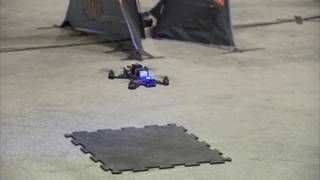
In another addition to the ever-expanding list of things robots can do better than humans, artificial intelligence has beaten one of NASA's world-class pilots in a drone race.
Researchers at NASA's jet propulsion lab in Pasadena, California, revealed Tuesday the results of two years spent developing algorithms for autonomous drones using technology also used for spacecraft navigation, funded by Google. The space agency put its AI to the test on October 12, finding that their robot was nimbler and did not get tired like a human pilot.
Related: A robot mocked Elon Musk and his grim AI predictions. He didn't take it well
The race, held on October 12, pitted NASA drone pilot Ken Loo against custom-built drones named after comic book characters Batman, Joker and Nightwing, capable of reaching speeds of up to 80 miles per hour. Over the course of the race, factors such as natural human aggression and fatigue gave the robots the advantage.
"We pitted our algorithms against a human, who flies a lot more by feel," Rob Reid, the project's task manager. "You can actually see that the AI flies the drone smoothly around the course, whereas human pilots tend to accelerate aggressively, so their path is jerkier."
To start with, both Loo and the AI achieved similar lap times but as they continued the robot drones learned the course and got faster whereas the human pilot slowed down due to mental exhaustion. "Our autonomous drones can fly much faster," Reid said. "One day you might see them racing professionally."
On the official lap times Loo was faster, he averaged 11.1 seconds, compared to the autonomous drones that averaged 13.9 seconds. But the drones were more consistent overall. Where Loo's times varied more, the AI was able to fly the same racing line every lap.
"This is definitely the densest track I've ever flown," Loo said. "One of my faults as a pilot is I get tired easily. When I get mentally fatigued, I start to get lost, even if I've flown the course 10 times."
However, it wasn't all bad news for team humanity. The drones sometimes moved too fast for themselves, meaning that a motion blur caused them to lose track of their surroundings. Loo was also able to do more impressive aerial acrobatics, such as corkscrews, which flummoxed the drones.
Robots have already started replacing humans in many walks of life. As many as 7.5 million retail jobs that don't require a great deal of human analysis are at risk of becoming automated, according to CNN, as are jobs for drivers because some of the world's biggest companies are investing billions of dollars to develop self-driving vehicles.
According to The Guardian, 72 percent of Americans are very or somewhat worried about a future where robots and computers are capable of performing many human jobs. Only a third of people said they were excited by the prospect.
Uncommon Knowledge
Newsweek is committed to challenging conventional wisdom and finding connections in the search for common ground.
Newsweek is committed to challenging conventional wisdom and finding connections in the search for common ground.
About the writer
Callum Paton is a staff writer at Newsweek specializing in North Africa and the Middle East. He has worked freelance ... Read more
To read how Newsweek uses AI as a newsroom tool, Click here.








